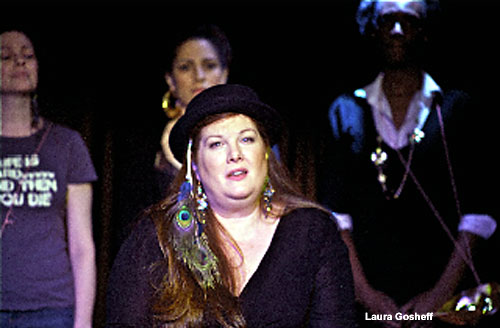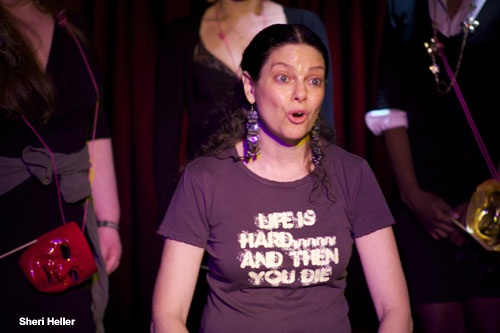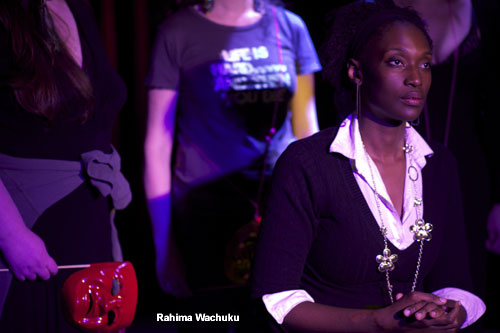|
"Sistah Tribe" is a collective of women committed to bringing therapeutic theater to disenfranchised, traumatized women and girls in the public sector. "Let the Phoenix Rise" is an autobiographical play authored by Sistah Tribe members Sheri Heller and Laura Gosheff. This dynamic production is based on the true stories of four troubled teenage girls, and their personal tribulations and triumphs over adversity. As they struggle to make sense out of the circumstances they were born into, their journeys become imbued with fairytale, magical images, symbolism and life affirming directives, conveyed in Greek Chorus tradition, all of which is guided by the Archetypal Mother who poses as a Counselor in order to assist their transformation.
Oscar Wilde wrote, "I regard the theatre as the greatest of all art forms, the most immediate way in which a human being can share with another the sense of what it is to be a human being." Sistah Tribe's performance of "Let the Phoenix Rise" carries the message that Oscar Wilde imparts; that theatre is one of the greatest vehicles by which one can creatively express the myriad dimensions of the human struggle. It is through performance that Sistah Tribe endeavors to communicate the belief that creativity, humanity, hope, and love somehow survive adversity.
It began one Sunday in Sept. 2008 when I met with a group of ten women at the Dance Theater Workshop in NYC. I was facilitating a full day therapeutic workshop concerning the plight of the archetypal orphan child, and the challenges she faces with discovering a personal path of survival as she encounters the internal and external dark forces of despair and alienation in her life. The workshop included writing, dance, meditation, improvisation, and ritual. Thereafter, I designed several more three-hour workshops for these women over the next few months, where we collaboratively explored and examined the most feared, dormant parts of ourselves, as well as our deepest aspirations. Eventually fairytale became a vehicle for infusing our personal stories with mythical imagery. Anguish and darkness is a common element in fairytale, as well as in life. It was there we confronted our wounds and disillusionment. It was there that we had the potential to face what is real, and be humanized by the experience.
Infusing our memories with fairytale has been instrumental in directing us on our paths toward growth. From this mythic perspective, the heroine faces the truth, and heals those internal and external conflicts that held her down and kept her trapped. She becomes herself, and actualizes all that she is meant to bring into her world and the world around her. It is through elevating our stories and struggles through fairytale, and discovering the wisdom inherent in our metaphorical interpretations, that we liberate the child so that she can express her freed up potentials. She is now able to connect beyond the wounded self and engage in life from a place of Divine creativity.
 |
As a result, through our unfolding process, it became evident that further growth and development required us to step beyond the personal to the transpersonal. Accordingly, Laura Gosheff and I committed to extending ourselves through creating "Let the Phoenix Rise," a play inspired by the creative process and writings from our workshops.
Creating a script that could adequately convey the various dimensions and layers of existence that characterized the lives of four girls beset by abuse and neglect was a daunting task. Through staged readings and work-shopping the material, we came to know those parts of ourselves, via our 'characters', that we previously shunned, denied, and feared. Repeatedly dramatizing memories rooted in our past has fostered a deeper connection to our adolescent selves, and has challenged us to viscerally remember the worlds we lived in.
 |
Our teenage selves emerged, and we were challenged to embrace her, and all her angst, vulnerability, bravado, terror, self-destructiveness, self-loathing, and despair. We also discovered how alive and irreverent and bold she was. We discovered her beauty and her strength in the face of desperately difficult odds. This has afforded catharsis and a reframing of our childhood circumstances, as well as our understanding of who we were, and continue to be, given our histories. Through this undertaking we came to experience firsthand how therapeutic theater can take on transformative and healing properties which impact one's total being.
The founder of psychodrama, Jacob Moreno, conveyed that by tapping into our spontaneity, we could find creative solutions to life's conflicts. Therein lay the possibility of transforming hopelessness into hope. For Sistah Tribe, theater is a therapeutic vehicle for tapping into that hope. Morphing suffering into art has been a reparative journey for us. Our performance has become us, and we've become our performance. Parts of ourselves that were previously hidden are now present in our waking consciousness, informing us of all that we are, and allowing us to be more fully authentic and alive.
 |
We've come to recognize that by aligning with the artistic and the abstract we held onto visions that helped us endure debilitating circumstances of abuse and neglect. Audiences have called it "moving and powerful," "brave theater," "stirring, provocative, achingly-triumphant," "raw storytelling at its best". This informed us that the triumphant stories of survival presented in "Let the Phoenix Rise" inspire others to create, to dream, to press on. There is shared identification and growth catalyzed by dramatizing narratives, which chronicle an archetypal journey of struggle and self-realization, which stirs the universal desire in each one of us to overcome our obstacles and reach within for authentic expression.
"Let the Phoenix Rise" sends the message that daring to challenge oppressive forces can liberate the life-giving creative energy, which leads to surrender and acceptance. The symbol of the Phoenix embodies this message. To emulate the Phoenix is to walk into the proverbial fire of immense challenges, so that one's worth and potential can be realized.
Like the Phoenix we are driven to persevere, and rise each time we fall. For those of us who have struggled with harrowing histories characterized by trauma, neglect and abuse, we beseech the power of the Phoenix to remind us of that fire within us that burns for truth and lights the way. She reminds us of hope that will not perish, and those magical inviolate parts of ourselves that cannot be destroyed. It is the Phoenix archetype that propelled Sistah Tribe forward with discovering the beauty in the ugliness and giving it form as sacred theater.
Guided by the artistic direction of Pamela Scott, "Let the Phoenix Rise" was presented in two staged readings by Aching Dogs Theater Company and actors from the American Academy of Dramatic Arts. In January 2011 Sistah Tribe presented "Let the Phoenix Rise" for girls from Phoenix House Substance Abuse Residential Program and girls in foster care from Represent Magazine, at the Center Stage Theater. In December 2010 Sistah Tribe received fiscal sponsorship from Fractured Atlas, a non-profit arts service organization. On April 30, 2011 The Sistah Tribe Theater Group presented the piece at the Producers Club Grand Theater, introducing music and lyrics written by Laura Gosheff and Daniel Neiden. The Sistah Tribe performers for the Producer's Club production were Brenda Crawley as the Counselor/Archetypal Mother, Laura Gosheff as Laura/Minette, Sheri Heller as Sheri/Sera, Vanessa Verduga as Carmen/Luna, and Rahima Wachuku as Uchenna/Zahara. The April 30th Producers Club performance took place with the endorsement from the organization GEMS, allowing us to share "Let the Phoenix Rise" with the girls they mentor.
Sistah Tribe hopes to impart through "Let the Phoenix Rise" that life itself is a creative process, which requires a reliance on metaphor, imagination, and creativity so as to heal wounds and restore faith. It is through the magic of theater that this message comes alive!
Sistah Tribe images — Courtesy of photographer/filmmaker Gleb Osatinski
|


